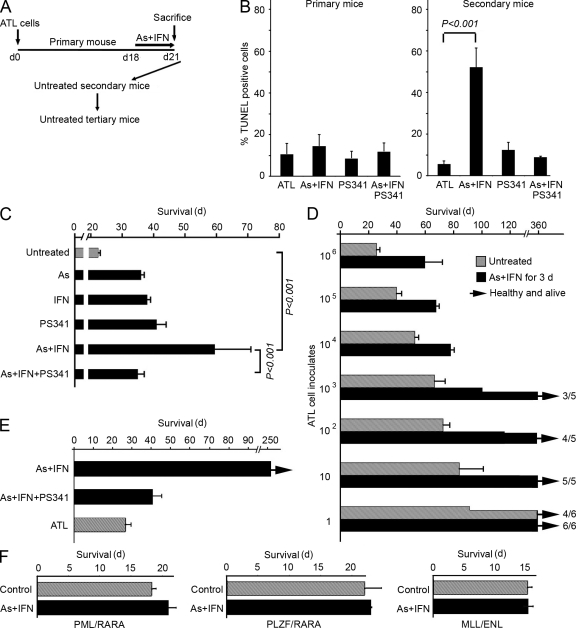Figure 3.
Loss of leukemia-initiating activity accounts for the therapeutic effect of the IFN-α + As2O3 combination. (A) Experimental design: serial transplantation of splenocytes from primary mice left untreated or after 3-d IFN-α + As2O3 treatment into secondary and tertiary recipients, which were not subsequently treated. (B) TUNEL staining of splenocytes from primary mice left untreated (ATL) or after 3-d IFN-α + As2O3 treatment (left) and of splenocytes from secondary recipients of ATL cells from untreated (ATL) or treated primary mice (n = 6 for control or IFN-α + As2O3 [As]; n = 3 for PS-341 or IFN-α + As2O3 + PS-341); the p-value is indicated. Secondary recipient cells were analyzed at the time of death of the mice. Secondary mice were not treated. (C) Effect of indicated 3-d treatment of primary donor mice on the survival of secondary recipients of 106 spleen ATL cells (n = 9 for each condition). This experiment was reproduced twice with similar results, as well as with two other independent primary ATLs (Fig. S3 C). (D) Survival of secondary recipient mice inoculated with varying initial amounts of ATL cells from primary mice either untreated or treated with IFN-α + As2O3 for 3 d (n = 10 for each condition). (E) Effect of 3-d treatment of primary mice on the survival of tertiary transplants (n = 10 for each condition). Secondary recipients were inoculated with 106 spleen ATL cells from primary mice. Tertiary recipients were inoculated with 106 spleen ATL cells from untreated secondary recipients. Tertiary mice were not treated. (F) Effect of 3-d treatment of primary mice on the survival of secondary recipients of leukemic cells from PML/RARA, PLZF/RARA APLs, or MLL/ENL leukemia (n = 3 for each condition). (B–F) Error bars show mean ± SD.

